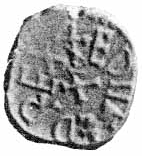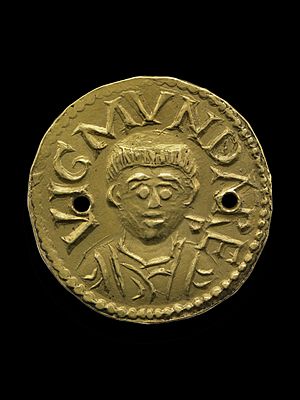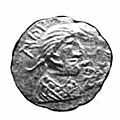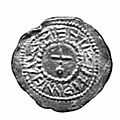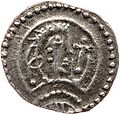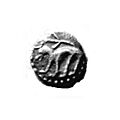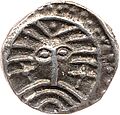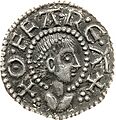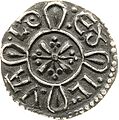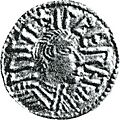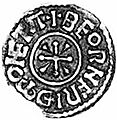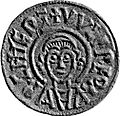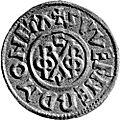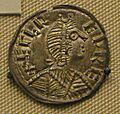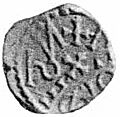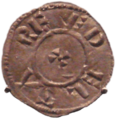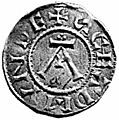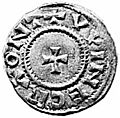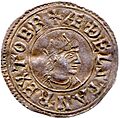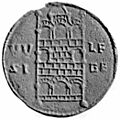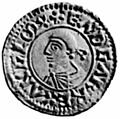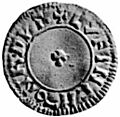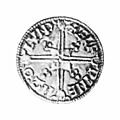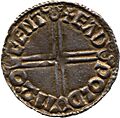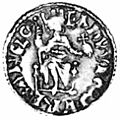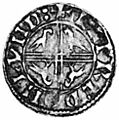History of the English penny (c. 600 – 1066) facts for kids
The history of the English penny goes way back to the Anglo-Saxon kingdoms in the 600s. These early coins were small, thick silver pieces. People at the time called them pæningas or denarii. Today, experts often call them sceattas.
Later, in the mid-700s, new pennies appeared in Southern England. These were wider and thinner, and they had the king's name on them. This type of coin was the main money in England until the 1300s.
Contents
- Understanding Anglo-Saxon Coins
- After Roman Rule: The Start of Anglo-Saxon Coins
- First Gold Coins: Thrymsas
- The Silver Coin Boom: Sceattas (c. 675 – c. 750)
- The New Broad Penny: Offa and His Time
- The 800s: Changes and Challenges
- Viking Coins in England
- The 900s: A Unified Coin System
- Edgar's Coin Reform (c. 973) and Later Anglo-Saxon Coins
- Images for kids
Understanding Anglo-Saxon Coins
The story of Anglo-Saxon coins covers more than 500 years. It starts after Roman rule ended in Britain in the 400s. It goes all the way to the death of Harold Godwinson at the Battle of Hastings in 1066. We can divide this long history into four main periods:
- Around 450 to 550: Not many coins were used in Britain. People mostly reused old Roman coins. Sometimes, they didn't even use them as money. A few coins also came from Gaul (modern France) and other parts of Europe.
- Around 550 to 680: This was the 'gold' period for money. More gold coins, mainly tremisses, started arriving from Europe. From about 620, English gold coins, called thrymsas, were made. By the mid-600s, these coins had less and less gold. By the 670s, they were almost entirely silver.
- Around 680 to 750 (or 867 in Northumbria): This was the time of the sceattas. These were small, thick silver coins. They developed from the gold coins that had lost most of their gold. These coins were likely called pennies or denarii back then. Most sceattas don't have writing, so it's hard to know who made them. In Northumbria, these coins were made under closer royal control until the 860s. However, by the early 800s, they had very little precious metal left.
- Around 750 to 1066: The silver sceattas stopped being made in southern England around the mid-700s. New, wider, thinner silver coins took their place. These were similar to coins from the Carolingian empire. These new coins had the king's name, the moneyer's name, and later, the mint's name. This coin style, with some changes in weight (1.00g to 1.70g) and silver purity, stayed standard. Silver pennies of this type were the main English money until the 1300s. English kings, starting with Offa, made these pennies. Viking rulers also made them from the late 800s.
In the early gold period, most coins were gold tremisses or thrymsas. They weighed about 1.10 to 1.30 grams. A few larger solidi also existed, like Roman coins. After that, the money was mostly based on one coin: the silver penny.
The first round halfpennies were made in the 870s. This happened under Alfred the Great and Ceolwulf II of Mercia. They were made only sometimes and in small amounts until Edgar's reform in the 970s. After that, it was common to cut whole pennies into halves and quarters. This was often done when they were first made.
Gold coins were not the main money after the 600s. But from the late 700s, some fine gold coins were used for special, expensive deals. These gold pieces were often called mancuses. Gold coins looked different in the 700s and 800s. They were inspired by Roman, Byzantine, Arabic, and Carolingian gold coins. By the 900s, gold coins were made using the same tools as regular silver coins. Only eight English gold coins with clear writing from before 1066 still exist.
It's hard to know exactly how much coins were used in Anglo-Saxon England. There are not many written records about making or using money. Even one silver penny was worth a lot, perhaps £10–£30 in today's money. Coins might have been used mostly by certain groups of people. They were probably used for things like paying rent, taxes, and legal fees.
However, finding single coins (especially with metal detectors since the 1970s) shows coins were used a lot. This was true especially in eastern England, both in and outside towns. They also traveled widely, often found far from where they were made. Many English coins have been found in other parts of Europe, like Italy and Scandinavia. English coin designs also influenced the new coins in Ireland, Denmark, Sweden, Norway, and Bohemia.
After Roman Rule: The Start of Anglo-Saxon Coins
At the end of the 300s, the Roman parts of Britain were still part of a strong money system. This system covered the whole Roman world. Gold and silver coins were used to pay taxes. Then, they were remade into new coins to pay soldiers and government workers. Bronze coins were made less often. They were mainly for trade in the provinces.
Making coins and controlling precious metals in the western Roman Empire was managed by a special official. Major mints were in places like Trier, Arles, Milan, and Rome. London had been a mint in the early 300s and again for a short time under Magnus Maximus. But by 400, coins came to Britain from mainland Europe.
Many coins have been found from the 300s and early 400s. But in the early 400s, things changed a lot. The supply of bronze coins almost stopped after about 402. Gold and silver coins also ran out by about 410. This happened around the time the British army left with Constantine III in 409. Many Hoards of coins and silver from this time are found in Britain. This was probably due to invasions, civil wars, and economic problems. Some of these hoards were very big. The Hoxne hoard from Norfolk, found in 1992, had over 15,000 coins, plus silver plates and jewelry.
Stopping the supply of new coins didn't immediately stop coin use. Coin experts and archaeologists have noticed a lot of 'clipped' siliquae from the early 400s. Clipping means cutting small pieces off the edge of a coin. The exact dates and reasons for this are still unclear. Clipping might have continued into the mid-400s or just in the 410s and 420s. It might have been a way for the government to collect taxes when they had no new coins. In this idea, coins of a certain weight would be brought in, clipped, and then reissued by number, not by weight.
 |
|
| Front: Bust of Valentinian II. | Back: Two emperors on thrones holding a globe. |
| Gold solidus of Valentinian II, made in Trier, 375-92. Found in an Anglo-Saxon grave in Hampshire. | |
The late 400s and 500s are very unclear in many ways, and coins are no different. The strong Roman money system was broken. Almost no new coins were made, and very few new coins came in. However, it seems that coins never completely disappeared. People kept reusing existing coins. New coins arrived only sometimes. Some Romano-British settlements that continued into this period have old coins still in use, like at Wroxeter.
Gold and bronze coins are often found at early Anglo-Saxon settlement sites and in graves. Many were pierced or set into Jewellery. It's hard to know exactly when a late Roman coin was lost. Some might have been used well into the time after Roman rule.
Thanks to metal-detecting, many more new imported coins from this period have been found recently. Hoards from this time are rare. But two were found recently at Oxborough (2001) and Patching (1997). Both are from the late 400s. The Patching hoard had fifty gold and silver coins from up to about 470. A few single finds from the same time show that coins kept flowing into Britain in the 400s and 500s.
It also seems that some Byzantine coinage was used in the 500s. Many gold and especially bronze coins have been found, even in western Britain. This area usually has fewer coin finds. This is similar to where North African pottery from the same time is found. However, many Byzantine bronze coins from this period were used as souvenirs. So, finds of them must be checked very carefully.
New coins from mainland Europe, mainly gold, continued to arrive throughout the 500s. Many Merovingian tremisses were used in southern and eastern England by the end of the 500s. These coins were the basis for the first English coins made in the early 600s.
First Gold Coins: Thrymsas
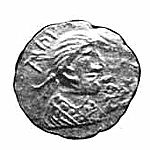 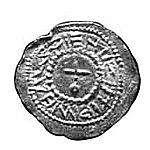 |
|
| Front: Bust of Eadbald. | Back: Cross on globe within wreath. |
| Gold thrymsa of Eadbald of Kent, London (?), 616-40. | |
The earliest known English coins are gold pieces. They were copied from Merovingian Frankish coins of the time. They were mostly tremisses, which were one-third of a gold solidus. A solidus originally weighed 4.5 grams. But in Anglo-Saxon England, they seemed to be based on a new standard of 3.9 grams, used in Gaul from the 580s.
Frankish coins became more important as money in England during the 500s. The first Anglo-Saxon gold tremisses (sometimes called thrymsas by coin experts) were made to be used alongside these Frankish coins. For example, all forty gold tremisses found in the burial at Sutton Hoo (buried around 630) were Frankish.
The earliest coins made in England can be dated to around 600. These include a gold tremissis made by a moneyer named Eusebius in Canterbury. There's also the Liudhard medalet, a gold medallion found in Canterbury. It has the name of Bishop Liudhard. This is likely the same bishop Bede wrote about, who came to England with Bertha, the Frankish wife of Æthelberht I of Kent.
The only large hoard of English coins from this time was found at Crondall. It contained 69 English tremisses and many Frankish tremisses. It was probably buried around 630. These and other finds show many different types of coins. They rarely name a mint or who issued them. However, one rare type has the name of London. Others are made in the name of King Eadbald of Kent (616–40). Their designs are based on Roman and Merovingian coins.
More coins from this period have been found in the last thirty years, thanks to metal detectors. Even so, these coins are still quite rare. Coin making was mainly in the south-east. But some were probably made in Northumbria, likely at York. Both English and Frankish gold coins were used widely. It's also unclear how coin making was organized. It might not have been just 'royal' coins. Bishops, abbots, important lords, and even individual moneyers might have made them.
Early Anglo-Saxon law-codes (which should be used carefully for this period) mention payments in scillingas and scættas from about 600. These words come from continental legal terms. They might have meant measures of value or weight, not actual coins. Still, it's likely that the gold tremisses made in 7th-century England were called scillingas.
The Silver Coin Boom: Sceattas (c. 675 – c. 750)
 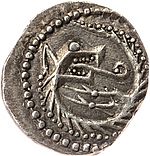 |
|
| Front: Head with crown, cross in front. | Back: Coiled wolf. |
| Silver sceat of series K, London (?), c. 710–20. | |
During the 600s, the gold in Anglo-Saxon and Frankish tremisses got worse. By the 660s, they were often only 10-20% pure gold. Around this time, there was a big change from low-quality gold to silver in Frankia. Within a few years of 675, very large amounts of silver coins were also being made in southeastern England.
Some coins, like those with the runic name Pada and the Latin Vanimundus, exist in both low-quality gold and silver. This suggests they were made during the changeover. The new silver coins were similar in size and weight to the later tremisses. They were small (usually 10-12mm wide), thick, and typically weighed 1–1.3 grams.
Because of the old law-codes, coin experts have called these new silver coins sceattas since the 1600s. We don't know for sure what they were called back then. But it's likely they were known as peningas (pennies), just like the later, wider pennies. Silver pennies of about this weight (1–1.6g) were the only type of English money until the 1200s. The only exceptions were rare silver halfpennies and even rarer gold coins.
The first sceattas (series A, B, and C) were mostly found in Kent and the Thames Estuary. But the 'secondary' sceattas (probably around 710) brought many new designs. Coin making spread to many new areas. By the middle of the 'secondary' phase, coins were made in Kent, the Thames Estuary, East Anglia, eastern Mercia, Northumbria, and Wessex.
Unfortunately, very few of these coins have any writing. Also, there was a lot of copying. This makes it very hard to figure out dates and minting places for many types. Experts group them into lettered series (like A, B, C) or by numbers from old British Museum catalogs. The current timeline for these coins was mostly set by Mark Blackburn in the mid-1980s. It's based on a large hoard found in southern Gaul, which contained sceattas alongside local coins that could be dated.
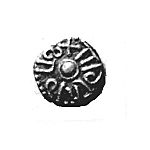  |
|
| Front: +ALDFRIDVS around center. | Back: Left-facing animal. |
| Silver sceat of Aldfrith of Northumbria, 685-704. | |
There's still much uncertainty about how sceattas were organized. We don't know exactly who was in charge of making them. Some types were made in such large numbers that only major rulers could have been behind them. Others are so rare that they might have been made by a single moneyer working alone. Some coins show important and complex religious symbols. This suggests they might have been made by monasteries or bishops.
An exception to the mystery of sceattas is in Northumbria. There, from very early on, the king and (arch)bishop of York played a strong role in making coins. King Aldfrith was the first English king named on any silver coin. His successors kept fairly tight control over coins after production started again under Eadberht.
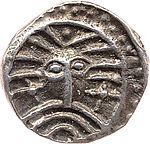  |
|
| Front: Facing head with beard and crosses. | Back: Right-facing curled 'dragon'. |
| Silver sceat of series X, Ribe, Denmark, c. 710–20. | |
The early 700s saw a huge amount of coin production and use. It was more than at any other time after the 300s and before the 1200s. About 2,500 sceattas have been found in England, especially in the east and south. This helps us study how they were used. Sceattas were also made and used in the Netherlands and probably Jutland (Denmark).
Mints in the Low Countries, like Dorestad and Domburg, supplied many coins used in England. They were among the most important trading centers in Europe. Sceattas give us valuable clues about how much trade happened across the North Sea in the early 700s.
The New Broad Penny: Offa and His Time
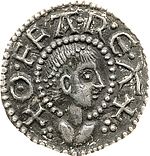  |
|
| Front: Head of Offa. | Back: Cross on a large circle. |
| 'Light' silver penny of Offa, moneyer Æthelweald, London, c. 775–92. | |
By the mid-700s, making sceattas had slowed down a lot, just like the thrymsas before them. The last coins from this period are rare and often have less silver. A lack of coins is seen at several archaeological sites that were busy before. Similar problems affected the Frankish kingdom too.
Around 754/5, King Pippin III (751–68) in Frankia decided to change the coins. He introduced a new, thinner, broader coin (at least 15mm wide) made of much purer silver. Importantly, these new coins all had the king's name and usually the name of the mint where they were made.
English rulers followed this idea around the same time. The first signs of this change outside Northumbria (where good silver coins were still made, though not always) were in East Anglia. There, a lesser-known ruler named Beonna changed the local coins sometime after he became king in 749. His coins have the king's name and the moneyer's name. They are somewhere between sceattas and the new Frankish pennies in style. Beonna's coins started with fine silver but later had less. However, one of his moneyers later made some of the earliest coins for Offa of Mercia.
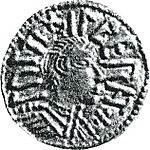 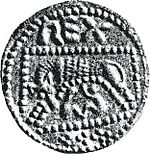 |
|
| Front: Draped head of Æthelberht. | Back: Wolf and twins in a frame. |
| Silver penny of Æthelberht, moneyer Lul, East Anglia, c. 779–94. | |
It was Offa who brought the broad penny to southern England in a big way. He made it standard to put the king's and moneyer's names on coins at at least three mints: Canterbury, London, and somewhere in East Anglia. His earliest coins had a short version of the royal title, like Pippin III's coins. On the back, they had the moneyer's name.
Early in his time (probably in the 760s or 770s), smaller amounts of coins were also made in Canterbury. These were in the names of two local Kentish kings, Heaberht (only one coin exists) and Ecgberht II. Broad silver pennies also continued to be made in East Anglia. They started in Offa's name but were later interrupted by coins made in the name of King Æthelberht II of East Anglia. Æthelberht was executed by Offa in 794. Only three of his coins survive today, probably made in the 780s or 790s.
Offa's coins are some of the best examples of Anglo-Saxon art. They were probably the most artistic coins made anywhere in Europe at that time. They were very different from the plain coins of Frankia. Portraits of the king were added early on. These portraits were made in different styles, showing influences from Roman art and the time.
The back of the coins had complex crosses. But Offa's coin makers also used other designs, like twisting snakes, eels, and the wolf and twins. Uniquely in Anglo-Saxon England, coins were also made in Canterbury in the name of the queen, Cynethryth. These were made using the same skilled person who made the best of Offa's portrait coins. This might have been inspired by Roman coins with empresses' names. It's also possible that the appearance of Irene on Byzantine coinage led Offa's queen to put her image on coins. Cynethryth seems to have been a strong person. She often signed important documents right after her husband. She was in charge of his household and became a powerful abbess after he died.
Like with the sceattas, there are many questions about how the new coins were organized. Offa's pennies might still show hints of the complex sceattas system. Different designs often varied from one moneyer to another. Other authorities also had the right to make coins during his reign. The Bishop of London (Eadberht) is named on some coins. These are the only pennies made in the name of an Anglo-Saxon bishop outside York and Canterbury. In Canterbury, Archbishops Iænberht (765–92) and Æthelheard (793–805) made coins both on their own and with Offa.
Dating the changes that brought this new penny coinage is also debated. It seems likely that production started at about the same time in London, Canterbury, and East Anglia, perhaps around 765–70. Most of the coins, including the portrait coins, were probably made in the 770s and 780s.
Later in Offa's reign, there was a second change. The coins became heavier, larger, and a common non-portrait design was used at all three mints. This 'heavy coinage' can be dated closely. No examples of it are known in Archbishop Iænberht's name. Also, no 'light' (before the change) pennies of Archbishop Æthelheard exist. This means the change happened in 792 or 793.
Offa's coins show a new level of royal power over coinage. Historians have paid a lot of attention to them because of their impressive images and different royal titles. Offa was called REX (King), REX M (King of Mercia), REX MERCIORU (King of Mercia), and probably REX A (King of the English).
The 800s: Changes and Challenges
 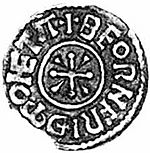 |
|
| Front: Draped head of Coenwulf. | Back: Cross with wedges. |
| Silver 'Cross-and-wedges' penny of Coenwulf, moneyer Beornferth, Canterbury, 805 – c. 810. | |
After Offa died in 796, new rulers in Kent and East Anglia, Eadbearht Præn and Eadwald, took power. They made coins in their own names, following Offa's heavy coin design. After a small issue in London using this same type, the new Mercian ruler Coenwulf changed the coinage. This led to the new tribrach type. This type had no portrait. Its front design was based on Queen Cynethryth's earlier coins. Even though it had a central M (for Mercia), Eadbearht, Eadwald, and even Beorhtric of Wessex used it. Beorhtric made a very rare coin around this time.
By 798, Coenwulf had taken back Kent. East Anglia also came under his control by the 800s. He appointed his brother, Cuthred, as a sub-ruler for Kent. Coins were made in Cuthred's name at Canterbury. Cuthred and his brother might have made coins at the same time using the cross-and-wedges portrait type from around 805. Or, they might have controlled the mint one after the other.
Around the same time, the archbishop's coins in Canterbury also changed. The new archbishop, Wulfred, wanted to show his church's power, even against the king. He started an archbishop's portrait coinage that didn't mention Coenwulf at all. This attractive series was based on the silver denarii made by Pope Hadrian I (772–95).
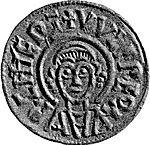  |
|
| Front: Head of Wulfred. | Back: Monogram of DOROVERNIA. |
| Silver penny of Wulfred, moneyer Swefherd, Canterbury, c. 815–22. | |
Coenwulf continued making portrait coins for the rest of his reign. This happened at Canterbury, London, East Anglia, and from about 810, at a new mint in Rochester. Canterbury became the main producer of silver coins. While East Anglia and Rochester stayed fairly steady, pennies from London became very rare. Even though a gold coin of Coenwulf with the name DE VICO LVNDONIAE (from London) was recently found, it's clear that the London mint was declining by around 800.
Between Coenwulf's death in 821 and Egbert of Wessex's takeover of Kent and the south-east in 825, the Canterbury mint went through a tough time. The coins show this better than any written records. Coenwulf's brother and successor Ceolwulf I held Kent. But coins in his name from Canterbury are very rare and made by only a few moneyers. Still, his short reign shows a strong interest in coinage. Several types common to many mints were introduced. This was something not seen in the later part of his predecessor's reign. The largest of these new types even included the usually separate East Anglian mint. Rochester became much more productive under Ceolwulf. This might have been to make up for lower royal production at Canterbury.
It seems that most of Canterbury's coins from around 822–24 were 'anonymous' pennies. They had a royal- or archbishop-style portrait. On the back, they had the moneyer's name and the mint name (Dorobernia civitas). No king or archbishop was mentioned. This interesting coinage seems to show a time when moneyers weren't sure whose authority to follow. This was probably around Ceolwulf's removal from power in 823 by Beornwulf. No Kentish coins are known in Beornwulf's name. But many are in the name of Baldred. He was probably another Mercian sub-ruler of Kent. It's hard to be sure from the very few written records of this time. However, we know that when Egbert of Wessex and his son Æthelwulf invaded Kent in 825, they made Baldred flee and took control.
Egbert's conquests went far beyond Kent. They even went through Mercia to the borders of Northumbria in 829–30. Unusually, this big military success was shown on coins from London. Egbert was named REX M (King of Mercia) on them. This is one of the very few times in Anglo-Saxon England where coins seem to have been used for propaganda. Coin design and production were not usually as closely linked to politics as in Roman or modern times.
After these conquests, Egbert pulled back and strengthened his power in the south-east. He left Mercia to Wiglaf, who made very rare coins in London. London was now the only mint available to the kings of Mercia. Egbert's coins from Kent at first continued Baldred's style. But they were changed around 828 to a new type with a monogram on the back. The front still had a portrait of the king. The archbishop's coin making stopped right after the West Saxon takeover. But it started again shortly before Wulfred's death. It used the same monogram on the back as the royal coins, with an archbishop's name and bust on the front. This type continued under Wulfred's successor Ceolnoth, who became archbishop in 833.
The 800s saw coin making spread beyond the south-east. This area had been the main producer outside Northumbria since the end of the sceattas. The West Saxon mint started by Beorhtric continued to operate at a low level under Egbert. But it remained very irregular between his death and Alfred's reign later in the 800s. In East Anglia, coin making slowly became more significant under the last Mercian rulers. From about 825, it continued under a series of independent rulers: Æthelstan, Æthelweard, and (St) Edmund. These kings mainly issued non-portrait pennies with a large central A. Other designs were often unique to individual moneyers, though made by a common die-cutter. When first used under Coenwulf, this central A probably meant part of an Alpha-Omega pair. But in East Anglia, it more likely meant Angli or (rex) Anglorum (King of the English).
Under Æthelwulf, coin making remained strong at Canterbury and Rochester. It continued in the name of Archbishop Ceolnoth throughout this period. Four phases can be seen at these two mints. At Canterbury, the first was a non-portrait coin with the words REX SAXONIORVM (King of the Saxons). This was inspired by Egbert's West Saxon coins. A new portrait coinage with many different designs on the back came second. At Rochester, the first type had a portrait and various designs made by royal moneyers. It also had a likely bishop's coin that didn't name a moneyer or have a portrait. But it did have the unusually long royal title REX OCCIDENTALIVM SAXONVM (King of the West Saxons). In the second phase, the bishop's coinage stopped, and a non-portrait type was adopted by the royal moneyers.
The last two phases of Æthelwulf's coinage were common to both Rochester and Canterbury. Dies for both mints in the final phase came from a single source at Canterbury. The third type of Æthelwulf's reign was a non-portrait coin with the unclear mint name DORIBI (which could mean Canterbury, Dorobernia; or Rochester, Dorobrebia) and a monogram for CANT (Kent).
Æthelwulf's last coinage was a new portrait type with a very different style. This inscribed cross type might have only started after several years without coins at Canterbury. Only two moneyers from there and Rochester survived from earlier types. This might be because of the Viking raid on Kent recorded in 851. This new coinage continued into the reign of Æthelwulf's son Æthelberht (no real coins are known of Æthelbald, who ruled 858–60). Under Æthelberht, it became very common. About forty moneyers are known to have made it.
Another new portrait type, the short-lived floreate cross type, also appeared at the end of his reign. But very few of these survive today. The inscribed cross type is mostly known thanks to a large hoard found at Dorking in the early 1800s. It is rarely found otherwise. So, the floreate cross coinage might have once been much more common than it seems today. The inscribed cross coinage is important because it marked the start of major debasement (less silver). It also saw the centralizing of die-cutting for Canterbury and Rochester. And there was a huge increase in the number of moneyers, almost 50 known from Æthelberht's time. These changes probably show a new, stronger royal control over coinage. This control would grow under Æthelberht's successors.
Mercian Coinage in the 800s
Under Berhtwulf of Mercia (c. 840–52), coin making in London, Mercia's only remaining mint, started again in a big way. This was around the time of Æthelwulf's second phase of coinage in the mid-840s. A mix of portrait and non-portrait coins were made. Because the London mint had been inactive for so long, it got a lot of help from West Saxon Rochester. This help came in the form of dies and even moneyers. It's possible that some coins in Berhtwulf's name were actually made in Rochester.
It was once thought that this coin cooperation was shown by a unique penny. It had Æthelwulf's name on one side and Berhtwulf's on the other. However, this coin is more likely an unofficial piece with no special political meaning.
The recovery of Mercian coin making was clearest when Wessex adopted the 'lunettes' type. This type was first made in London by Berhtwulf's successor Burgred. Many of these coins survive today. This is thanks to a big increase in coin making, especially in the later part of Burgred's reign. About twenty moneyers are known for Alfred and 35–40 for Burgred. This period is well known because many hoards have been found. These hoards were likely related to Viking raids. This coinage is very hard to organize or categorize.
However, the lunettes type had very little silver by the early 870s. This was probably when production was at its highest. Another change was started in the mid-870s by Alfred ('the Great') of Wessex. This brought in the heavier, purer cross-and-lozenge type. This happened after some very rare and interesting experimental coins were made around the time of the change.
In London, which was in the Mercian kingdom, Alfred was first recognized as king of Mercia as well as Wessex. This was after Burgred was removed from power in 873/4. Alfred was even called REX ANG (King of the English) on one of two known examples of the two emperors portrait penny type. The other coin of this interesting type is in the name of Ceolwulf II. He was the new Mercian king put in place by the Vikings. Ceolwulf also made pennies of the cross and type. The earliest known round English halfpenny belongs to this phase of coinage.
Alfred started further changes later in his reign. Around 880, London made a new series of portrait pennies. They had Alfred's portrait and, on the back, a Monogram of Lundonia (London). Later, one moneyer, Tilewine, put his name on the back too. But most of these coins were made without moneyers' names.
The main type made in the later part of Alfred's reign was the non-portrait two line type. Again, a few different and perhaps experimental types have survived in small numbers. These include a portrait coin, probably from around the same time as the London monogram pennies. It has the mint-name ÆT GLEAPA ('from Gloucester'). Gloucester had become an important center of 'English' Mercia under Alfred's ealdorman Æthelred. There were also a small number of 'four-line' non-portrait pennies. Their reverse mint names show they were made in Winchester and Exeter. Another non-portrait series was probably made in Oxford (OHSNAFORDA). And there were large silver 'offering pieces' inscribed ELIMOSINA ('alms').
Northumbrian Coins in the 800s
Northumbria's coin history was quite different from the south. Coin making never completely stopped there, like it did south of the Humber River. Until near the end of its history, Northumbrian coins remained closely linked to the king and archbishop. However, coins started to have much less silver around the end of the 700s. Coin experts began to call Northumbrian coins stycas around this time. This name comes from a 900s note in the Lindisfarne Gospels. We don't know what they were called back then. Both the political and coin timelines of this period are very confusing. Many ideas and suggestions compete with each other. By the mid-800s, Northumbrian coins had almost no silver. They were being made in huge numbers.
Many tens of thousands of these coins are known today. Several very large hoards have been found. For example, one from the churchyard in Hexham had about 8,000 stycas. After a final period of great disorganization, the stycas were stopped by the Scandinavian rulers. These rulers took over Northumbria in 867. They replaced them with new pennies, like the coins in the Carolingian empire and southern England.
Two special coins show that Northumbrian coinage in the 800s might not have been only stycas. A gold Mancus exists in the name of Archbishop Wigmund. It was copied from gold solidi of Louis the Pious. Also, a silver penny was found in the Cornish Trewhiddle hoard (from about 868). It is in the name of EANRED REX. It has a strange reverse inscription that seems to read ĐES MONETA ('his coin'(?)) followed by an Omega. This last coin has not been fully understood. Its style suggests it was made around 850. But Eanred of Northumbria probably died in 840. So, it might be a coin made to remember him after his death. Or, it could be a very rare coin from southern England in the name of a forgotten ruler.
The styca coinage was studied a lot by Elizabeth Pirie. She created a very important list of known finds in her book Coins of the Kingdom of Northumbria.
Viking Coins in England
Viking settlers in England found a more advanced economy that used coins. They were not used to this at home. So, it's not surprising that the first coins linked to Vikings in England were copies of Alfred's coins. These were especially copies of the 'London monogram' and 'two-line' types. Many of these exist today. For a long time, they made it very hard for coin experts studying Alfred's coins. They couldn't always tell them apart from the real ones.
However, before the end of the 800s, new silver coins began to be made in East Anglia and at York. In East Anglia, coins were made to copy Alfred's in the name of Guthrum (who also used his baptismal name Æthelstan). Then, a very large number of coins were made naming the martyred Saint Edmund on the front. At least sixty moneyers made these coins. Most of them had names showing they came from mainland Europe. This coinage continued until Edward the Elder conquered East Anglia in 917/18.
In Northumbria, the very low-quality styca coinage ended. It was replaced with fine silver coins. We know a lot about these thanks to the huge Cuerdale hoard (about 8,000 coins). This hoard was buried in the first ten years of the 900s.
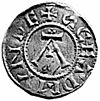  |
|
| Front: Large A within circle. | Back: Circle with small cross. |
| Silver penny of St Edmund Memorial Coinage, moneyer Wine, East Anglia, c. 895–910. | |
Sometimes these coins named local Viking rulers. It's often hard to match these rulers with figures from written history. But at the start of the 900s, the mint's name and Saint Peter's name replaced references to the king and moneyer. From the 910s, the York coinage started naming the ruler again. It also began to show interesting symbols related to the Scandinavian presence in York. These included swords, hammers, banners, and a bird (either a raven or a dove). The York pennies of Anlaf/Olaf Guthfrithson (939–41) are the first known use of Old Norse in the Latin alphabet. The words ANLAF CVNVNGIR mean 'King Anlaf'.
Northumbria and East Anglia were the main places for Viking coins. But at different times, coins were also made in the East Midlands. For example, coins naming Saint Martin were made at Lincoln.
The 900s: A Unified Coin System
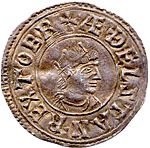 [[|150px]] [[|150px]] |
|
| Front: Crowned head of Athelstan. | Back: Circle with central cross. |
| Silver 'Bust crowned' penny of Athelstan, moneyer Otic, Winchester, c. 927–39. | |
The coins of Edward the Elder continued the styles and organization from his father Alfred in Wessex and English Mercia. But as West Saxon control grew into the Midlands and East Anglia, the money system became more complex. New regions were added to Edward's kingdom. For the most part, the coins had no portraits and simple designs. However, some mints in English Mercia made an interesting series of coins with pictures on the back.
Since mint names are very rare again, we often have to guess where coins were made. We do this by looking at Æthelstan's reign. During his time, mint names were often found on coins of the circumscription cross and bust crowned types. These coins were made at about thirty named mints after the conquest of the kingdom of York in 927. They show a new effort by the king to have a single, centrally controlled coin system across the kingdom.
Coin types were made standard. The royal title was expanded from the usual REX (King) to REX SAXONUM (King of the Saxons) or even REX TO BRIT (King of All Britain). This is similar to what is found in documents from that time. It was also under Æthelstan that coins were first mentioned in detail in legal documents. A law-code he issued at Grateley (probably around 926-30) talks about accepting a single currency and punishments for fake coins. It also lists minting places and how many moneyers each was allowed.
 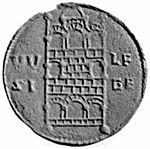 |
|
| Front: Circle with small cross. | Back: City gate. |
| Silver penny of Edward the Elder, moneyer Wulfsige, 899-924. | |
Towards the end of Æthelstan's reign and during the time of his successors Edmund, Eadred, Eadwig, and the first part of Edgar's reign, the coinage was regional. There were up to seven areas where money was used. This system is clearest for northern England because more hoards have been found there. Coins usually stayed within the area where they were made. Different types were used in each region. However, these regions changed, and many 'regional' types looked quite similar to someone who wasn't an expert.
The most common type had the king's name written around the edge on the front (usually around a small cross). On the back, the moneyer's name was in two lines with different decorations. Sometimes, a design with writing around the edge was also used on the back, allowing for a longer message. Or, a portrait of the king was on the front. For unknown reasons, East Anglia especially liked royal portraits between the 930s and 970s. Though portraits were also used sometimes elsewhere. Mints are not usually named, but it's usually possible to guess the region where a coin was made.
Despite the regional types and circulation, pennies remained fairly stable in size, weight, and silver purity. Most importantly, they were always made in the name of the West Saxon king. Even when the kingdom was divided between Eadwig and Edgar in 957, coin making seems to have been Eadwig's job. He was the senior ruler, even in the mint towns ruled by Edgar.
The last phase of this regional coinage, made in the first ten years of Edgar's sole reign, had some unusual features. Mint names became more common. There were also some designs copied from earlier English coins. For example, Alfred's London monogram was brought back on halfpennies. And Æthelstan's royal title REX TO BRIT (King of All Britain) was used again. This renewed interest in coins hinted at an even bigger change at the end of Edgar's reign.
Edgar's Coin Reform (c. 973) and Later Anglo-Saxon Coins
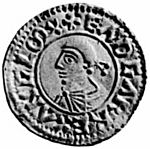  |
|
| Front: Head of Edgar. | Back: Small cross. |
| Silver 'Reform' penny of Edgar, moneyer Lyfing, Norwich, c. 973–75. | |
We don't know exactly when Edgar changed the coins. But it was clearly towards the end of his reign. The only written help is from a 1200s chronicle by Roger of Wendover. It suggests the reform might have happened in or after 973. Its effect was huge. It became the basis of English coinage until the time of Henry II.
Old coins disappeared. A single, standard type was introduced at about forty mints across the country. These coins had the king's portrait and title on the front. On the back, they had the names of the moneyer and the mint around a small cross. At first, all new coin dies were sent out from one place in Winchester. This kind of central control was unusual. It only happened in a few later coin types. More often, the same type was used everywhere. But die production was handled by several regional centers. These centers then sent dies to smaller mints nearby.
Even during the nine-month reign of Harold II in 1066, coins with a new design were made in his name at forty-eight mints. About seventy places in England (and in Wales under the Normans) were active as mints during this period. They varied greatly in size and how many coins they made. The largest was London. But York and Lincoln remained important. Other major mints included Winchester, Norwich, and Stamford. At the other end of the scale were places that were never important mints in the Anglo-Saxon period. Today, they are little more than villages, hillforts, and market towns. These include Melton Mowbray, Milborne Port, Castle Gotha, Cadbury Castle, and Dunwich. Mints like these were often only active for short times. For example, some 'emergency' mints were set up during the reign of Æthelred II because of Viking attacks.
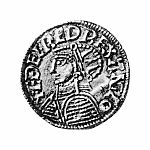 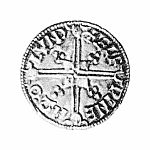 |
|
| Front: Helmeted head of Æthelred. | Back: Long cross with central shape. |
| Silver 'Helmet' penny of Æthelred II, moneyer Ælfwine, London, c. 1003–09. | |
The coin designs were quite similar. They followed the pattern of Edgar's reformed pennies. The front had some kind of royal portrait, plus the king's name and title. The back gave the moneyer's name and the mint around some kind of cross. But within this style, there was a lot of variety. Portraits could face either way and showed many different influences.
Under Æthelred II, for example, one type was based on early 300s Roman coins. These showed the emperor in military clothes, with a helmet and armor. Another was based on civilian portraits of other 300s emperors without any headgear. Under Edward the Confessor, there was a strong German influence in the portraits from the last fifteen years of his reign. This might be because Edward hired German goldsmiths named Theoderic and Otto. These coins show the king with a beard, helmet, and crown. In some cases, he even faces straight forward or sits on a throne.
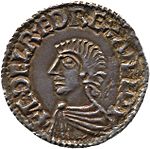 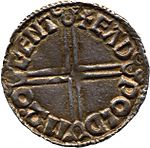 |
|
| Front: Draped head of Æthelred. | Back: Long cross. |
| Silver 'Long Cross' penny of Æthelred II, moneyer Eadwold, Canterbury, c. 997–1003. | |
The names of the moneyer and mint on every coin are very useful. They help us study not only how mints were organized (like how many coins certain moneyers made, or how many shared dies). They also show us naming patterns of the time and, to some extent, the population's makeup. Mints in the old Danelaw, like York and Lincoln, had many moneyers with Scandinavian names. Sometimes, moneyers all over the country had names from mainland Europe, or even more unusual names from Old Irish.
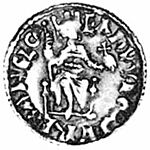 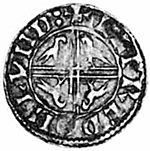 |
|
| Front: King seated on throne. | Back: Cross with birds. |
| Silver 'Sovereign eagles' penny of Edward the Confessor, moneyer Ælfwine, London, c. 1050–60. | |
This first type, known as the First small cross or Reform type, was used during Edgar's last years. It also lasted through all of Edward the Martyr's short reign and into the first years of Æthelred II, who became king in 978/9. At some point early in his reign, another key feature of the late Anglo-Saxon money system appeared: the first of many changes in coin types.
More than fifty such changes happened during the time of the coinage reformed by Edgar. This system lasted until the 1150s. For example, during Æthelred's reign, six such changes can be seen. These are shown by the following types: First Small cross; First hand; Second hand; Crux; Long Cross; Helmet; Last Small cross.
After the death of Cnut, under whom three more types (Quatrefoil, Helmet, and Short cross) were made, types became more numerous. Changes probably happened more often. Fourteen types were made between 1035 and the Norman Conquest of 1066. Each probably lasted only two or three years. It's thought that each change of type required old coins to be exchanged for new ones. The king and the moneyer would take a cut, either as a part of the new coins' value or from the making process.
The weight of the coins varied a lot, even within the same type. This suggests that some profit might have been made by taking silver from the coins during minting. However, within England, it would have been possible to make sure all coins were accepted at their face value, no matter their weight.
Evidence from coin hoards, at least before the 1030s, suggests that all coins had to be remade with each type change. This is because many hoards only contain one type of coin. However, alongside these are 'savings' hoards, which have a mix of two or more types. A mix of types becomes much more common in hoards from after the 1030s. One possible reason for this change is that after the 1030s, only payments to the crown had to be in the current type. Other types of English coins might have been fine for other uses.
Very little written evidence survives to help coin experts and historians understand how the coinage and its system of type changes actually worked. Domesday Book does record that moneyers at certain mints had to go to London to buy new dies for twenty shillings quando moneta vertebatur ('when the coinage was changed'). It also says that certain towns paid yearly amounts to the king for the right to run a mint. In several towns, bishops and abbots had rights to the profits from one or more moneyers (which usually went to the king). But these rights are no longer shown by any changes in the coin designs.
| [[|150px]][[|150px]] | |
| Front: Lamb of God walking with scepter. | Back: Dove with extended wings. |
| Silver 'Agnus Dei' penny of Æthelred II, moneyer Blacaman, Derby, c. 1009. | |
Coin experts have sometimes tried to find a very strict system in the late Anglo-Saxon coinage. One expert, Michael Dolley, believed that until the death of Cnut in 1035, each type lasted six years. There were a few exceptions, like the Last Small Cross type at the end of Æthelred's reign, which lasted longer under unusual conditions. Some things seem to support this idea, at least for the earlier period.
Certain type changes apparently happened at the same time as historical events that can be dated. For example, no coins of the Helmet type survive from the mint of Wilton. But no coins of the previous Long Cross type are known from nearby Salisbury. However, moneyers with the same names as those from Wilton started working in Salisbury for the Helmet type. The Anglo-Saxon Chronicle records that in 1003, Wilton was attacked by Vikings. The people moved to Salisbury. It's likely that the change of coin type happened at the same time as this event.
However, there are some problems with creating such a fixed timeline. Not all coin types are well represented in the coins that survive. It's clear that this isn't always just because a few large hoards skew our view. There are some very small and rare types that were certainly never meant to be full coin issues. But some are clearly related to them. Examples from the reign of Æthelred II include the Benediction Hand type and the Intermediate Small Cross type. There's also the famous Agnus Dei type. This is a unique and interesting coin where the king's portrait and the cross on the back are replaced by the Lamb of God and the Holy Dove.
The exact reason for making this very rare coinage is unclear (eighteen coins survived as of November 2008). It was only made at smaller mints, mostly in the midlands. It might have been a failed main issue, or a special religious coin for a specific purpose. Although the dating is unclear, it might be linked to the Eynsham gathering and a religious order in 1009.
But the problems with the six-year theory are not just for smaller, rarer types. Æthelred's Second Hand type, for example, didn't look much different from the one before it. This raises the question of how easily people would have told them apart. More importantly, only tiny numbers of this type survive from northern mints like Lincoln and York. These mints were some of the most productive in the kingdom during the rest of the period. It's possible that the Second Hand type was a continuation of the First Hand type. The First Hand type might have lasted longer than six years as part of a system that allowed for type changes, but not necessarily on a strict six-year schedule.
The late Anglo-Saxon coinage is best understood for the period around 990 to 1030. This is thanks to the discovery of many tens of thousands of coins in hoards from Scandinavia. Connections between England and Scandinavia were very close at this time. Raiders, traders, soldiers, and eventually kings regularly crossed the North Sea. English coins in Scandinavian hoards probably include some profit from raids and the payments called Danegeld. Payments to Danish troops hired by English kings continued until 1051. That's when Edward the Confessor sent the last of them away. English coin finds in Scandinavia become even fewer after this time. However, many Arabic and later German coins from around the same time have also been found in Scandinavia. So, it's likely that most English coins arrived through trade, not military action.
Images for kids



